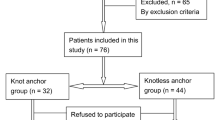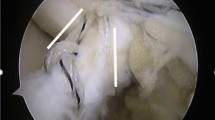Abstract
Purpose
To compare the function and activity level after one-anchor repair versus two-anchor repair of the anterior talofibular ligament (ATFL) in patients with chronic lateral ankle instability.
Methods
All patients who underwent arthroscopic surgical ATFL repair using suture anchors were included in this study. The American Orthopedic Foot and Ankle Society (AOFAS) score, Karlsson Ankle Functional Score (Karlsson score) and Tegner activity score were used to evaluate ankle function at a follow-up of a minimum of 2 years. A magnetic resonance imaging (MRI) scan was performed to evaluate the repaired ATFL.
Results
A total of 51 patients with chronic ankle instability were included in this study. Among them, 20 patients accepted a one-anchor repair procedure (one-anchor group), and the other 31 patients accepted a two-anchor repair procedure (two-anchor group). At the final follow-up, there was no significant difference in the AOFAS score between the one-anchor group and the two-anchor group (90 ± 9 vs 91 ± 10; ns). However, the mean Karlsson score of the two-anchor group (88 ± 12) was significantly higher than that of the one-anchor group (80 ± 14) (p = 0.04). There was a significant difference in activity level as measured by the Tegner activity score (5 ± 1 vs 4 ± 1; p < 0.001) between the two-anchor group and the one-anchor group after surgery. Patients in the two-anchor group (68%) had a significantly higher percentage of sport participation compared to those in the one-anchor group (30%) (p = 0.01).
Conclusion
Compared with a one-anchor repair, a two-anchor repair of the lateral ankle ligament produced better functional outcomes. Arthroscopic ATFL repair with two anchors provided a minimally invasive technique with a higher rate of return to sports than repair with one anchor. The present study showed its clinical relevance by maintaining the advantage of ATFL repair using two anchors regarding the clinical function.
Level of evidence
III.




Similar content being viewed by others
References
Acevedo JI, Mangone P (2015) Ankle instability and arthroscopic lateral ligament repair. Foot Ankle Clin 20(1):59–69
Acevedo JI, Mangone P (2015) Arthroscopic brostrom technique. Foot Ankle Int 36(4):465–473
Acevedo JI, Ortiz C, Golano P, Nery C (2015) ArthroBrostrom lateral ankle stabilization technique: an anatomic study. Am J Sports Med 43(10):2564–2571
Ahn HW, Lee KB (2016) Comparison of the modified Brostrom procedure for chronic lateral ankle instability with and without subfibular ossicle. Am J Sports Med 44(12):3158–3164
Biercevicz AM, Miranda DL, Machan JT, Murray MM, Fleming BC (2013) In Situ, noninvasive, T2*-weighted MRI-derived parameters predict ex vivo structural properties of an anterior cruciate ligament reconstruction or bioenhanced primary repair in a porcine model. Am J Sports Med 41(3):560–566
Corte-Real NM, Moreira RM (2009) Arthroscopic repair of chronic lateral ankle instability. Foot Ankle Int 30(3):213–217
Cottom JM, Baker JS, Richardson PE, Maker JM (2016) A biomechanical comparison of 3 different arthroscopic lateral ankle stabilization techniques in 36 cadaveric ankles. J Foot Ankle Surg 55(6):1229–1233
Cottom JM, Rigby RB (2013) The "all inside" arthroscopic Brostrom procedure: a prospective study of 40 consecutive patients. J Foot Ankle Surg 52(5):568–574
Dierckman BD, Ferkel RD (2015) Anatomic reconstruction with a semitendinosus allograft for chronic lateral ankle instability. Am J Sports Med 43(8):1941–1950
Fleming BC, Vajapeyam S, Connolly SA, Magarian EM, Murray MM (2011) The use of magnetic resonance imaging to predict ACL graft structural properties. J Biomech 44(16):2843–2846
Giza E, Whitlow SR, Williams BT, Acevedo JI, Mangone PG, Haytmanek CT et al (2015) Biomechanical analysis of an arthroscopic Brostrom ankle ligament repair and a suture anchor-augmented repair. Foot Ankle Int 36(7):836–841
Guillo S, Bauer T, Lee JW, Takao M, Kong SW, Stone JW et al (2013) Consensus in chronic ankle instability: aetiology, assessment, surgical indications and place for arthroscopy. Orthop Traumatol Surg Res 99(8 Suppl):S411–419
Hua Y, Chen S, Li Y, Chen J, Li H (2010) Combination of modified Brostrom procedure with ankle arthroscopy for chronic ankle instability accompanied by intra-articular symptoms. Arthroscopy 26(4):524–528
Jiang D, Ao YF, Jiao C, Xie X, Chen LX, Guo QW et al (2018) Concurrent arthroscopic osteochondral lesion treatment and lateral ankle ligament repair has no substantial effect on the outcome of chronic lateral ankle instability. Knee Surg Sports Traumatol Arthrosc 26(10):3129–3134
Kim ES, Lee KT, Park JS, Lee YK (2011) Arthroscopic anterior talofibular ligament repair for chronic ankle instability with a suture anchor technique. Orthopedics 34(4):273
Li H, Hua Y, Li H, Li S, Ma K, Chen S (2018) Treatment of talus osteochondral defects in chronic lateral unstable ankles: small-sized lateral chondral lesions had good clinical outcomes. Knee Surg Sports Traumatol Arthrosc 26(7):2116–2122
Li SK, Song YJ, Li H, Wei B, Hua YH, Li HY (2018) Arthroscopic treatment combined with the ankle stabilization procedure is effective for sinus tarsi syndrome in patients with chronic ankle instability. Knee Surg Sports Traumatol Arthrosc 26(10):3135–3139
Li X, Killie H, Guerrero P, Busconi BD (2009) Anatomical reconstruction for chronic lateral ankle instability in the high-demand athlete: functional outcomes after the modified Brostrom repair using suture anchors. Am J Sports Med 37(3):488–494
Lui TH (2015) Modified arthroscopic Brostrom procedure. Foot Ankle Surg 21(3):216–219
Maffulli N, Del Buono A, Maffulli GD, Oliva F, Testa V, Capasso G et al (2013) Isolated anterior talofibular ligament Brostrom repair for chronic lateral ankle instability: 9-year follow-up. Am J Sports Med 41(4):858–864
Matheny LM, Johnson NS, Liechti DJ, Clanton TO (2016) Activity level and function after lateral ankle ligament repair versus reconstruction. Am J Sports Med 44(5):1301–1308
Matsui K, Takao M, Miyamoto W, Innami K, Matsushita T (2014) Arthroscopic Brostrom repair with Gould augmentation via an accessory anterolateral port for lateral instability of the ankle. Arch Orthop Trauma Surg 134(10):1461–1467
Nery C, Raduan F, Del Buono A, Asaumi ID, Cohen M, Maffulli N (2011) Arthroscopic-assisted Brostrom-Gould for chronic ankle instability: a long-term follow-up. Am J Sports Med 39(11):2381–2388
Pearce CJ, Tourne Y, Zellers J, Terrier R, Toschi P, Silbernagel KG et al (2016) Rehabilitation after anatomical ankle ligament repair or reconstruction. Knee Surg Sports Traumatol Arthrosc 24(4):1130–1139
Petrera M, Dwyer T, Theodoropoulos JS, Ogilvie-Harris DJ (2014) Short- to medium-term outcomes after a modified Brostrom repair for lateral ankle instability with immediate postoperative weightbearing. Am J Sports Med 42(7):1542–1548
Shawen SB, Dworak T, Anderson RB (2016) Return to play following ankle sprain and lateral ligament reconstruction. Clin Sports Med 35(4):697–709
Takao M, Matsui K, Stone JW, Glazebrook MA, Kennedy JG, Guillo S et al (2016) Arthroscopic anterior talofibular ligament repair for lateral instability of the ankle. Knee Surg Sports Traumatol Arthrosc 24(4):1003–1006
Tassignon B, Verschueren J, Delahunt E, Smith M, Vicenzino B, Verhagen E et al (2019) Criteria-based return to sport decision-making following lateral ankle sprain injury: a systematic review and narrative synthesis. Sports Med 49(4):601–619
Viens NA, Wijdicks CA, Campbell KJ, Laprade RF, Clanton TO (2014) Anterior talofibular ligament ruptures, part 1: biomechanical comparison of augmented Brostrom repair techniques with the intact anterior talofibular ligament. Am J Sports Med 42(2):405–411
Waldrop NE 3rd, Wijdicks CA, Jansson KS, LaPrade RF, Clanton TO (2012) Anatomic suture anchor versus the Brostrom technique for anterior talofibular ligament repair: a biomechanical comparison. Am J Sports Med 40(11):2590–2596
Funding
No external funding was used.
Author information
Authors and Affiliations
Corresponding author
Ethics declarations
Conflict of interest
The authors report no conflict of interest.
Ethical approval
The study was approved by the Health Sciences Institutional Review Board of XX Hospital. All procedures performed in studies involving human participants were in accordance with the ethical standards of the institutional and/or national research committee and with the 1964 Helsinki Declaration and its later amendments or comparable ethical standards.
Informed consent
Written consent was obtained from all participants.
Additional information
Publisher's Note
Springer Nature remains neutral with regard to jurisdictional claims in published maps and institutional affiliations.
Rights and permissions
About this article
Cite this article
Li, H., Hua, Y., Li, H. et al. Anterior talofibular ligament (ATFL) repair using two suture anchors produced better functional outcomes than using one suture anchor for the treatment of chronic lateral ankle instability. Knee Surg Sports Traumatol Arthrosc 28, 221–226 (2020). https://doi.org/10.1007/s00167-019-05550-y
Received:
Accepted:
Published:
Issue Date:
DOI: https://doi.org/10.1007/s00167-019-05550-y




